
Background information
The big monitor preview 2024
by Samuel Buchmann

The Asus PG32UCDP is one of the first monitors equipped with LG’s new WOLED panel. Nevertheless, it still has both pros and cons compared to the QD OLED competition.
2024 is the year of 32-inch 4K OLEDs. Almost every manufacturer is releasing a monitor of that type, most of them with a QD OLED panel from Samsung. Find out what this means and how it differs from other technologies here:
I’ve already tested three QD OLED models, including the Asus ROG Swift PG32UCDM, my favourite monitor until recently. But now, the Asus ROG Swift PG32UCDP is standing in front of me. It uses a WOLED panel from LG and has a trick up its sleeve: it can switch between UHD at 240 hertz and Full HD at 480 hertz at the touch of a button.
The manufacturer specifications at a glance:
In this article, I’m focusing primarily on image quality. In particular, in the differences between QD-OLED and WOLED. You can read an assessment of their designs, operation and connections in my PG32UCDM test. They’re identical.
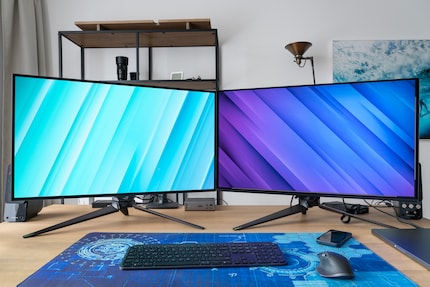
The Asus PG32UCDP cost 1,535 francs at time of testing, can only be ordered in Switzerland and isn’t yet available from stock. The Asus PG32UCDM costs 1,364 francs or 1,489 euros and is now readily available after an initial shortage.
The following is a deep dive. Measurements carried out with professional tools from Portrait Display allow an objective classification of image quality. If you’re not interested in details and diagrams, you can read the short version and then scroll to the «Gaming» section.
Here’s a summary of the key stats:
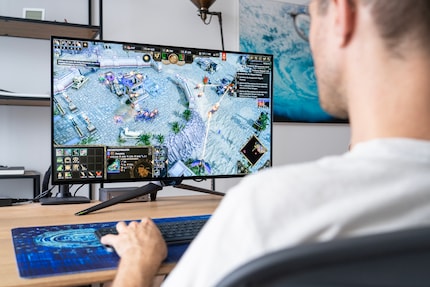
LG’s WOLED panel in the Asus PG32UCDP achieves a maximum full-screen brightness of just under 274 nits. This is marginally higher than its QD OLED brother, sufficient for most situations – unless the sun’s shining directly into your room.
Dynamic brightness is also activated by default. The less white content (more precisely, the lower Average Picture Level, APL) an image has, the brighter white becomes. With an APL of 10 per cent or less, the panel achieves 440 nits in SDR mode.
This makes gaming in bright rooms more pleasant than with OLED monitors, which don’t offer this option. Examples for these would be the Alienware AW3225QF or the Samsung Odyssey OLED G8. Especially in games, APL is almost always below 100 per cent, no matter if white brightness constantly changes a little.
The panel of my test sample is pretty evenly illuminated. I measure a maximum DeltaE of 2 between the centre and the edges of the image. However, I notice a slight dirty screen effect with plain images – a problem QD OLED models didn’t have.
HDR brightness reaches 1,210 nits in the 2 per cent window. This value is better than that of QD OLED models. At a higher APL, however, it drops just as quickly. I’m disappointed. With other Asus WOLED monitors, such as the PG34WCDM, you get more from a 10 per cent window.
As is usual with OLED monitors, the contrast tends towards infinity – black is really black. This is especially true for the PG32UCDP in daylight. Unlike its QD OLED competitors, the WOLED panel has a polarisation filter that reduces reflections within the panel. With QD OLED monitors, reflections like these turn black into dark purple.
A deep black would look best on a glossy monitor. However, the PG32UCDP has a matte coating. It disperses pointed light sources over a relatively large area, which worsens black levels depending on the situation. But in the end, the WOLED monitor is still ahead of QD OLED models during the day.
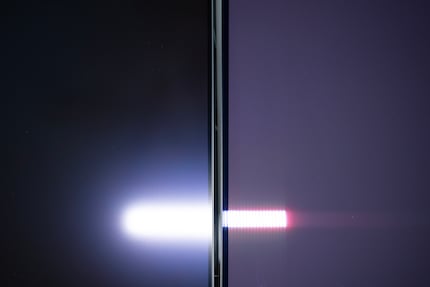
Measuring colours and grey tones is intended to answer three questions:
The grey tones of the PG32UCDP are very well-calibrated ex-works. Its gamma curve is close to the target value, contrast tends to be slightly too high. In very dark areas, you can’t always recognise every detail. This is remedied by the Shadow Boost option, although it raises the dark tones quite considerably. All shades of grey are displayed in neutral colours, the average DeltaE of 0.7 is in the invisible range.
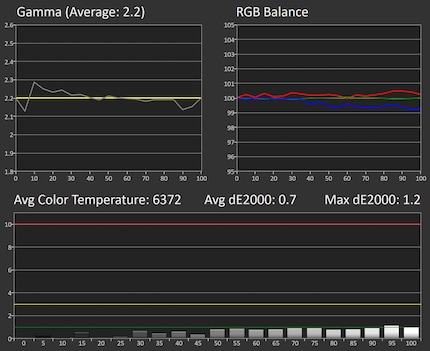
The PG32UCDP covers the common SDR colour spaces very well:
Adobe RGB coverage isn’t quite as good as QD OLED monitors, which scratch past 98 per cent. At 95.6, the PG32UCDP isn’t ideal for professional prepress. However, as a gaming monitor, it doesn’t have to be.
Asus has clearly designed the screen for the DCI-P3 colour space. There, it’s extremely accurate in its native setting (maximum DeltaE of 1.1). As with all WideGamut monitors, sRGB content is too saturated under Windows (maximum DeltaE of 6.8). Manually switching to sRGB mode reduces the maximum DeltaE to 3.5.
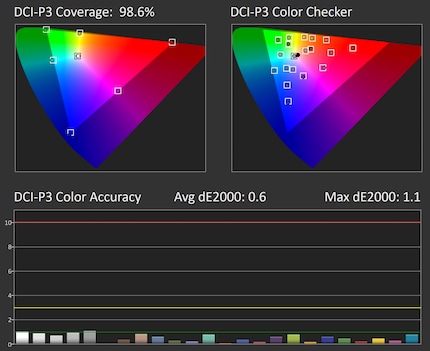
OLED monitors are well suited for HDR content. By switching off individual pixels, they can achieve precise demarcations between very bright and very dark content, such as explosions in a night scene. Even dark shades of grey usually transition cleanly so that details remain visible in the shadows.
Overall, the PG32UCDP is well-tuned. The grey tone curve (EOTF) and luminance curve deviate slightly more from their target values than on the QD OLED PG32UCDM – especially if you activate full brightness in the menu. Light-grey tones in particular are displayed too brightly, which is why they sometimes burn out. The luminosity of the panel also falls rapidly when the white component increases. The monitor only achieves an official peak specification of 1,300 nits in the 1 per cent window.
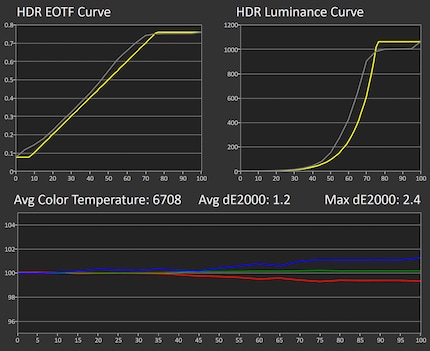
In terms of covering the HDR colour spaces, I measure:
The coverage of the very large BT.2020 colour space is in the typical range for WOLED monitors at just under 75 per cent. Although it isn’t as good with QD OLED, this hardly matters in practice. Most content today is aligned with DCI-P3. This colour space is excellently covered by the PG32UCDP at 99%, and the monitor displays colours very accurately, even in HDR.
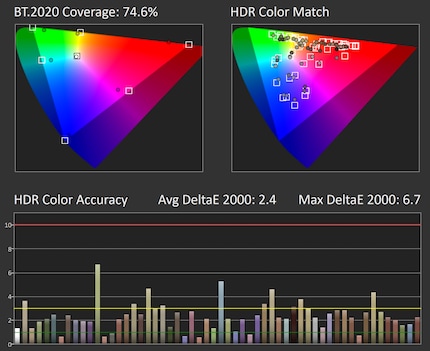
At the time of testing, the Asus PG32UCDP supports the HDR10 standard, but no HDR10+ or DolbyVision. Since there are few games in DolbyVision anyway, this isn’t too tragic.
If you mainly use your monitor for gaming, you can’t go wrong with any of the current 4K OLEDs. They all offer high pixel density, a pleasant format and brilliant image quality. In fast-paced games, the frame rate of 240 Hertz also leads to less annoying motion blur.
The Asus PG32UCDP has an additional ace up its sleeve with Dual Mode. It can also be operated as a 1080p monitor with a full 480 hertz. In this mode, it’s one of the fastest OLEDs around. Even very rapid movements don’t blur together. This is particularly useful if you play competitive shooters.
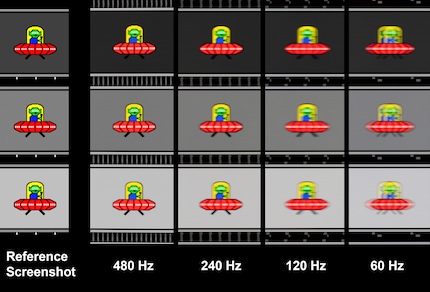
Full HD resolution means four times fewer pixels. This has its pros and cons. The good? Your graphics card doesn’t have to work as hard – despite the doubled maximum frame rate. The bad? A lower resolution leads to a less detailed picture. 1,080p across 32 inches doesn’t look particularly sharp. It’s up to you whether you prefer sharpness or more efficient GPU performance.
Prefer playing your shooter in 4K, but your PC can’t manage 240 frames per second (FPS)? Then you can use Black Frame Insertion (BFI) with the PG32UCDP, as with all newer Asus OLEDs. On these models, it’s called Extreme Low Motion Blur (ELMB). Here’s how it works. The monitor displays 120 fps with the same level of motion blur as it would at 240 fps by inserting a black frame between two images. However, this only works without Variable Refresh Rate (VRR) and halves the maximum brightness.
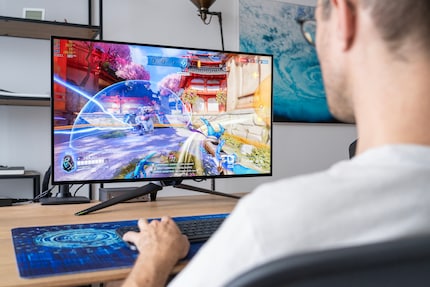
OLED Anti Flicker is a completely new feature. All OLED panels can suffer from a flickering image at variable picture frequencies (VRR), but they’re perceived differently by everyone who looks at them, not only depending on the model, but on the device too. As a result, OLED flicker can’t be reliably tested. Asus is trying to reduce this by limiting the VRR range with the new feature. For example, to 120 to 240 hertz instead of 48 to 240 hertz.
The big question now: Which 4K OLED should you buy for gaming? The Asus PG32UCDP ranks at the top of the list with its Dual Mode. It offers top picture quality, good settings and a stable design. The only drawbacks for me are the matte coating and high price. At the time of testing, the PG32UCDP costs more than all competitors – including the LG 32GS95UE, which has the same panel but fewer features.
If you’re going to benefit from Dual Mode and other features, this surcharge may be worth it. For casual gamers like me, however, other models offer better value for money. The Alienware AW3225QF, for example, costs less than two thirds of the PG32UCDP – and has hardly any disadvantages in most situations. Asus’ own QD OLED brother, the PG32UCDM, is also slightly cheaper.
In the past, WOLED suffered from four drawbacks in office work:
However, the Asus PG32UCDP uses a panel from the latest LG generation. It largely eliminates the first two points. The pixel density is much better at 140 ppi, and the new sub-pixel pattern (RGWB) is closer to the classic RGB that Windows and MacOS expect.

This means that the sharpness of text is perfectly fine for everyday use. To me, models with a QD OLED panel and a glossy coating look slightly sharper, but the test images (see above) prove my eyes wrong. Another thing the two Asus monitors have in common is that the dynamic brightness (Auto Brightness Limiter) can be switched off using Uniform Brightness, which I highly recommend, especially for image editing. And they’re both silent thanks to passive cooling.
The only disadvantage for office use is the risk of burn-in. After three weeks of using the Asus PG32UCDP, I’ve yet to notice any signs of ghosting. But this isn’t a meaningful long-term test. As with all OLED monitors, displaying static image elements for hours on end isn’t a good idea.
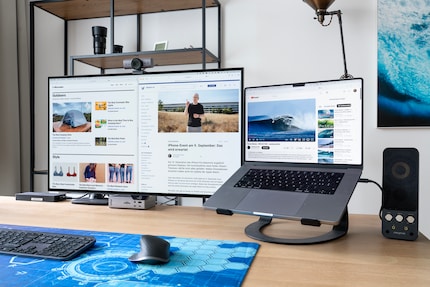
Asus uses the usual protective measures against burn-in. Static logos are automatically recognised and dimmed, the image shifts regularly by a few pixels. All these options can also be deactivated, which I’d advise against. A Pixel Cleaner frees the panel from temporary ghost images. Asus also offers a three-year burn-in warranty.
The Asus ROG Swift PG32UCDP is one of the best monitors you can buy right now. Most of you will probably be familiar with the advantages of 4K OLEDs by now: deep blacks, bright and accurate colours, high frame rates, good pixel density and a great all-round format. The PG32UCDP cuts a fine figure in both gaming and office applications.
It’s one of the first models to come with a LG WOLED panel instead of a Samsung QD OLED, featuring a matte instead of a glossy coating and slightly poorer colour space coverage. However, the screen is less susceptible to bright ambient light. Black remains black, unlike with QD OLED, where it becomes more of a dark purple.
There are also a few unique features such as the new OLED Anti Flicker and Dual Mode. The latter ensures extremely low motion blur at the expense of resolution. If you play competitive shooters, this can be useful – but casual gamers will hardly want to play in 1080p on 32 inches.
The finish, ease of use, connections and features are all top class. Only one problem: as with all OLEDs, there’s a certain risk of burn-in. In addition, the PG32UCDP is currently pricier than all competing models. If you really want the additional features or mainly play in bright rooms, it’s worth the extra cost. Otherwise, QD OLED models offer more bang for your buck.
Pro
Contra
My fingerprint often changes so drastically that my MacBook doesn't recognise it anymore. The reason? If I'm not clinging to a monitor or camera, I'm probably clinging to a rockface by the tips of my fingers.